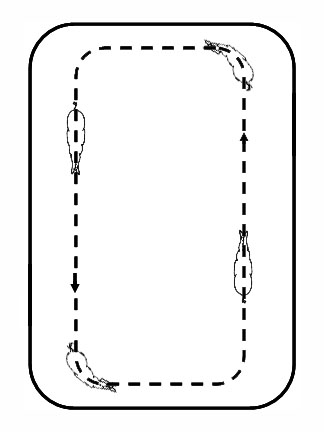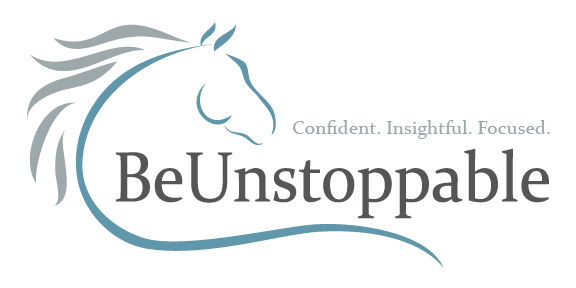The quality of a horse’s stop is directly related to the quality of his rundown. This exercise, in which you build to rundown speed, slow and collect instead of stopping, then go around the end of your arena and build to rundown speed again, is perfect for working on your rundown without the wear and tear of too many stops.
It also helps “take the brace out” of your horse’s stop as he learns to “downshift” his weight back on to his hocks to slow down, just as he must when he actually stops. If his first response to being slowed is to drop onto his front end, that’s what he’ll do when he stops, and that’s exactly what you don’t want. By not stopping, but instead just downshifting, you can reprogram that response.
The Runaround also helps you develop greater speed in your rundown. Many horses have a low “do not exceed speed” (if you do exceed it he’ll start to think he’s a wild horse!) By pushing your horse up to that speed, backing off and asking him to collect up and soften, then nudging him up to it again, you can desensitize him to going fast. He learns to “stay with you” and continue to respond as you “pour the coal on.” Every horse can develop a higher do-not-exceed speed, but some will remain more balanced and in control than others. This exercise helps your horse achieve his best, most controlled rundown speed.
Finally, if you practice the Runaround properly, your horse will naturally begin to slide in his stops. How far he slides will ultimately be determined by his genetics, your feel and timing, the quality of the ground, the nature of his hind sliding plates, and how he feels (i.e., whether or not he’s sore). But working on the Runaround will improve the quality of his rundowns, which will naturally improve the quality of his stop. In other words, work more on your run, and the stop and slide will take care of itself.


Thank you for your sharing. I am worried that I lack creative ideas. It is your article that makes me full of hope. Thank you. But, I have a question, can you help me?
Can you be more specific about the content of your article? After reading it, I still have some doubts. Hope you can help me.
Your point of view caught my eye and was very interesting. Thanks. I have a question for you.
Thanks for sharing. I read many of your blog posts, cool, your blog is very good.
Your point of view caught my eye and was very interesting. Thanks. I have a question for you.
Your article helped me a lot, is there any more related content? Thanks!
Can you be more specific about the content of your article? After reading it, I still have some doubts. Hope you can help me.
Your article helped me a lot, is there any more related content? Thanks!
Thanks for sharing. I read many of your blog posts, cool, your blog is very good.
This was explained very well. I need to give myself more time slow down and collect before the fence. This was helpful
Thanks for the feedback Gail
how slow when you do this. or just slower than your run down?
Maximum collection towards the end of the arena length and be sure they’re all the way back off the bit and slowed down before you turn the corner. If you can’t get them collected, continue straight into the fence and back them up, then try again
awesome article
I really needed this article right now. It is right where I’m at in my journey.
Thank you!
That’s great! If you have any problems, be sure to let me know
Thank you for describing this exercise in such detail. All of my maneuvers are improving, but I still struggle getting the stops right. My horse can do it, it’s me that needs to learn. I fear I am messing her up by my wonky stops. Even though I try and collapse into the stop, I notice my shoulders are up by my ears and I bounce out of the saddle. 🤷♀️ . Maybe I am not asking at the correct part of the stride? Only 1 out of 10 stops or so feels correct. Anyways, thank you and Barb for… Read more »
Very helpful article. Can’t wait to try it out!
Love getting this kind of information!
Thanks
Thanks for this exercise! As an English rider (show jumping) of thirty years my biggest challenge is to find the body position that facilitates an effective stop from my horse. I tend to squeeze and tense my legs and butt and try to throw my shoulders back. I’m also over anticipating the stop like I’m riding towards a fence which causes a brace to occur. At this point I’m trying so hard to *not* brace that it’s creating a mental and physical brace that I can’t get past. My horse is well built, knows how to do a basic baby… Read more »
Hi Claire, I hope it helps you. Additionally, you might exhale and when almost all of your air is out, then say “whoa”. It might help you not to brace and it will help you ask fr the stop in the correct part of your horse’s stride
I love this exercise and do it all the time at home! Jo Anne C taught it to me (although she didn’t give it a name). I hardly ever stop at home but my ponies have learned to run straight and drag their fannies doing this. Thanks again Barb and Sandy! I am going to have my daughter read this so she doesn’t think I’m nuts (she’s 12 and I have her do this too!)
Ha! yes it’s hard to convince kids that we oldsters know anything!
Can’t wait to try this. Have been working on faster and more collected rundowns and this sounds like it will help. My mare has great stop but my rundown could be a lot better.
Hope it helps! Call me if you run into any trouble with it